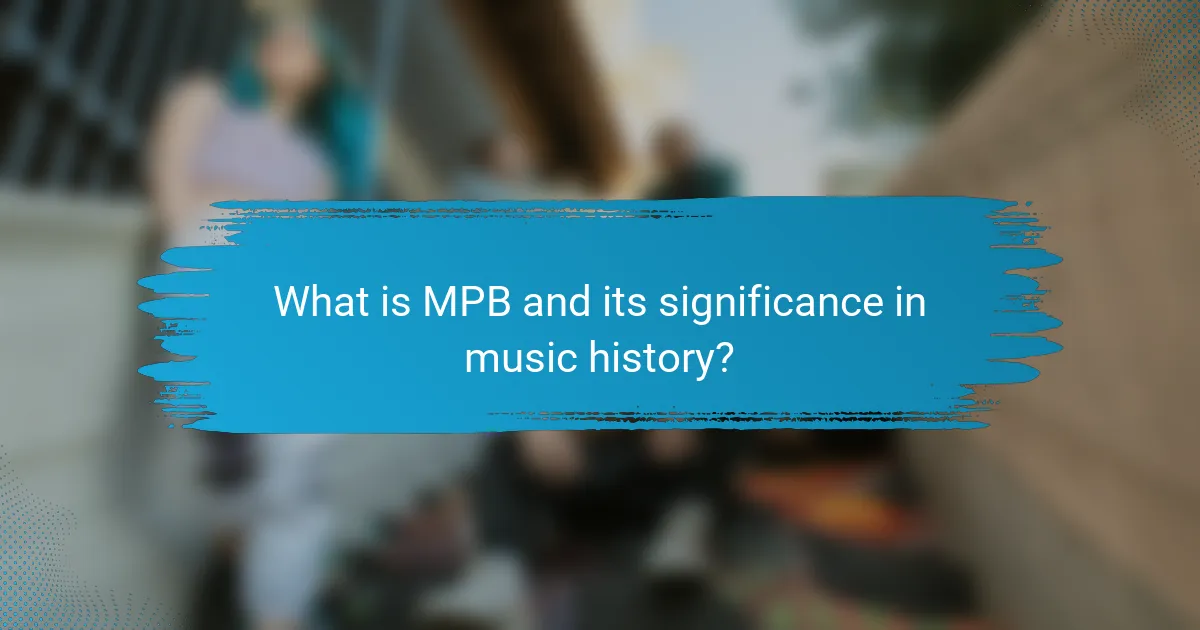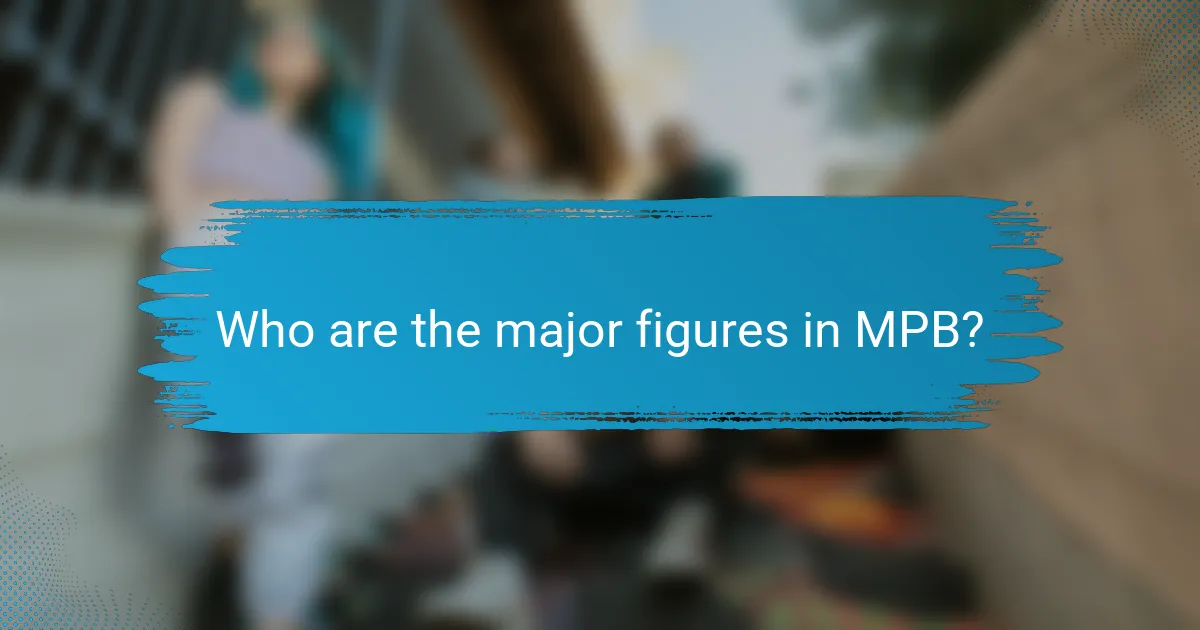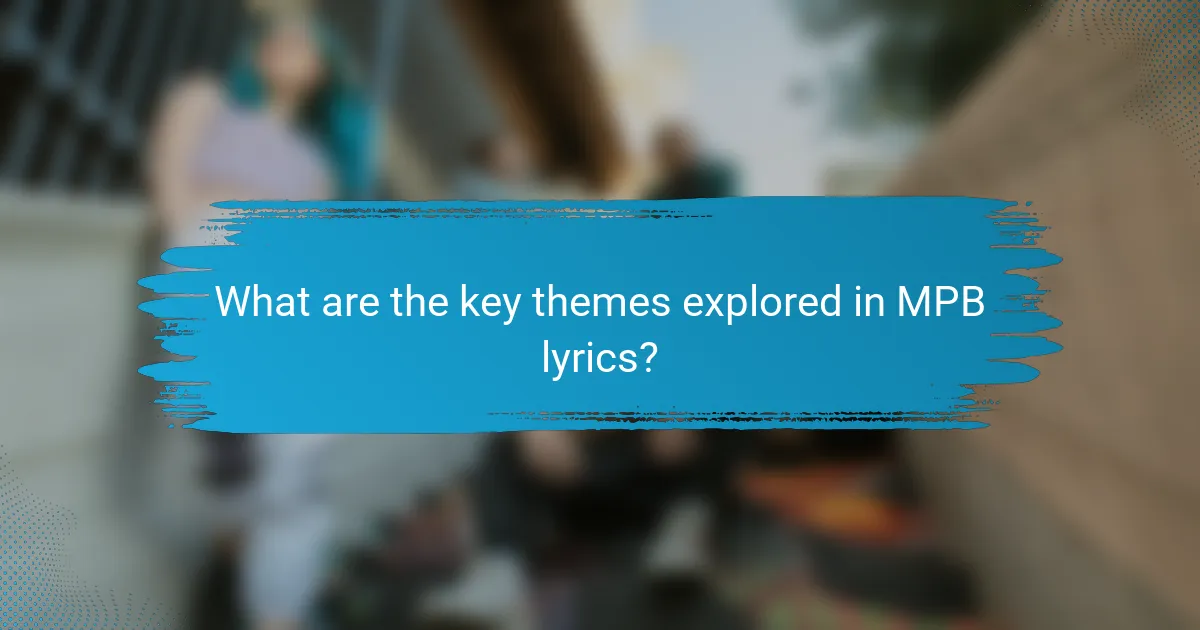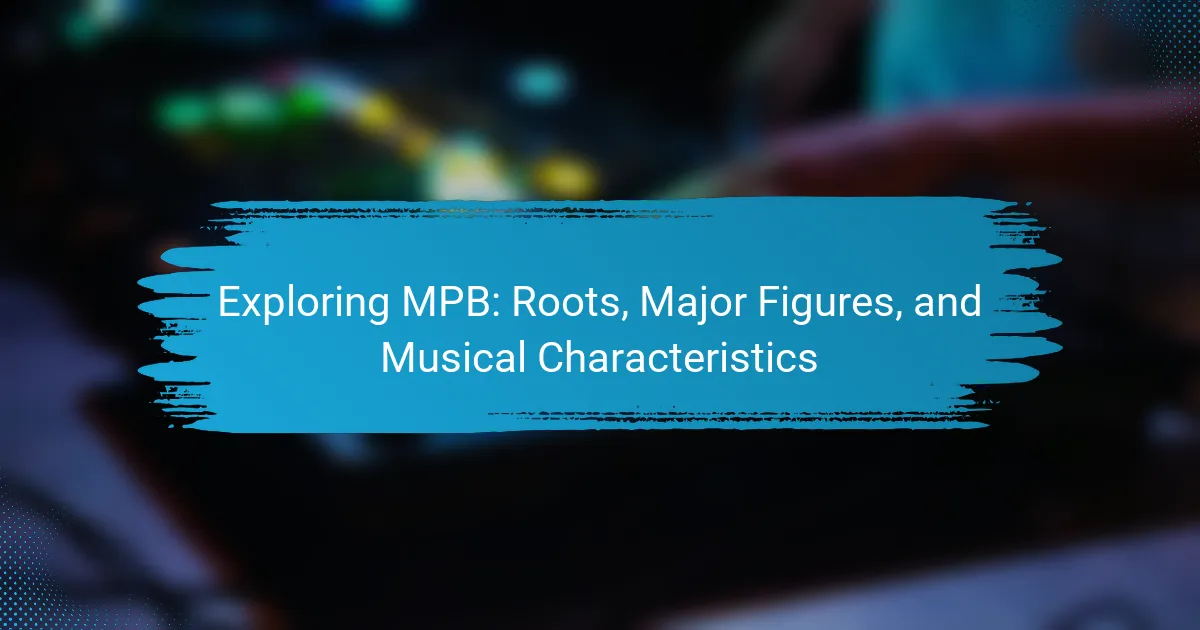Música Popular Brasileira (MPB) is a genre that combines traditional Brazilian music styles with international influences, emerging in the 1960s amidst Brazil’s cultural and political changes. This genre has produced influential artists such as Caetano Veloso, Gilberto Gil, Elis Regina, and Gal Costa, who have significantly shaped its landscape. MPB explores key themes including social issues, love, cultural identity, and environmental concerns, reflecting the complexities of Brazilian society. The genre is also closely associated with the Tropicália movement, which challenged societal norms and addressed political issues through music. This article examines the roots, major figures, and musical characteristics of MPB, highlighting its impact on contemporary music both in Brazil and globally.

What is MPB and its significance in music history?
MPB, or Música Popular Brasileira, is a genre of Brazilian music that blends traditional Brazilian styles with international influences. It emerged in the 1960s, reflecting Brazil’s cultural and political landscape. MPB is significant in music history as it represents a fusion of genres, including bossa nova, samba, and rock. This genre gave rise to influential artists such as Caetano Veloso and Gilberto Gil. MPB played a crucial role in the cultural movement known as Tropicália. It challenged societal norms and addressed political issues through art. The genre has shaped contemporary Brazilian music, influencing various artists worldwide.
How did MPB evolve over time?
MPB, or Música Popular Brasileira, evolved significantly from the 1960s to the present. Initially, it emerged as a fusion of traditional Brazilian music styles with international influences like jazz and rock. Key figures such as Caetano Veloso and Gilberto Gil played pivotal roles in shaping its sound during the Tropicalia movement. Over time, MPB incorporated various genres, including samba, bossa nova, and folk music. The 1980s saw a diversification of styles, with artists exploring themes of social and political relevance. In the 1990s and 2000s, MPB embraced technology, leading to new sounds and production techniques. Today, MPB continues to evolve, reflecting contemporary issues and blending with global music trends. This ongoing evolution keeps MPB relevant in the global music scene.
What cultural influences shaped the development of MPB?
MPB, or Música Popular Brasileira, was shaped by a blend of diverse cultural influences. African rhythms significantly contributed to its development, especially through genres like samba. European musical traditions, particularly from Portugal, also played a crucial role in forming MPB’s melodic structures. Indigenous Brazilian music added unique elements, enriching the overall sound. The fusion of these influences created a distinct genre that reflects Brazil’s multicultural identity. Notable figures like Caetano Veloso and Gilberto Gil further integrated global music styles, enhancing MPB’s evolution. The historical context of Brazil’s social changes in the 1960s also influenced MPB, as artists used music for political expression. This rich tapestry of cultural influences underscores MPB’s significance in Brazil’s musical landscape.
How did historical events impact MPB’s emergence?
Historical events significantly influenced the emergence of MPB (Música Popular Brasileira). The military dictatorship in Brazil from 1964 to 1985 led to censorship and repression. This environment pushed artists to express dissent and social issues through music. The Tropicália movement in the late 1960s blended traditional Brazilian styles with international influences. This fusion was a direct response to political turmoil. Additionally, the cultural exchange during the 1960s and 1970s introduced new genres to Brazilian music. The economic changes in Brazil also affected music production and distribution. These historical contexts shaped MPB’s identity and evolution.
What are the defining characteristics of MPB?
MPB, or Música Popular Brasileira, is characterized by its fusion of diverse musical styles. It blends traditional Brazilian genres like samba and bossa nova with international influences such as jazz and rock. MPB often features rich, poetic lyrics that reflect social and political themes. The instrumentation commonly includes guitars, pianos, and percussion, creating a vibrant sound. Notable artists like Caetano Veloso and Gilberto Gil have significantly shaped the genre. MPB emerged in the 1960s, during a period of cultural and political upheaval in Brazil. This genre is known for its artistic innovation and experimentation. Its defining characteristics contribute to its status as a vital part of Brazilian culture.
What musical elements are commonly found in MPB?
MPB, or Música Popular Brasileira, commonly features a blend of diverse musical elements. These elements include samba, bossa nova, and folk influences. MPB often incorporates complex harmonies and rich melodies. Instruments like the guitar, piano, and various percussion are frequently used. The genre emphasizes lyrical storytelling, reflecting social and political themes. Additionally, improvisation plays a significant role in many MPB performances. The fusion of traditional Brazilian rhythms with international styles is also a hallmark of MPB. This eclectic mix contributes to its unique sound and cultural significance.
How does MPB differ from other Brazilian music genres?
MPB, or Música Popular Brasileira, differs from other Brazilian music genres through its fusion of diverse musical styles and social commentary. MPB incorporates elements of samba, bossa nova, and rock, creating a unique sound. This genre often emphasizes lyrical depth and poetic expression. Artists like Caetano Veloso and Gilberto Gil have shaped MPB with their innovative approaches. Unlike traditional samba, MPB addresses contemporary social and political issues. The genre emerged in the 1960s, reflecting Brazil’s cultural and political landscape. MPB’s complexity in instrumentation and arrangement sets it apart from simpler genres like forró and pagode. Its emphasis on artistic expression and cultural identity is a defining characteristic.

Who are the major figures in MPB?
The major figures in MPB (Música Popular Brasileira) include Caetano Veloso, Gilberto Gil, Elis Regina, and Gal Costa. Caetano Veloso is known for his innovative approach to music and lyrics. He gained prominence in the 1960s and is a key figure in the Tropicália movement. Gilberto Gil, a fellow Tropicália artist, blends traditional Brazilian music with international influences. Elis Regina is celebrated for her powerful voice and emotive performances. Gal Costa, also part of the Tropicália movement, is known for her unique vocal style and eclectic repertoire. These artists have significantly shaped the landscape of MPB and influenced generations of musicians.
What contributions did influential artists make to MPB?
Influential artists made significant contributions to Música Popular Brasileira (MPB) by blending various musical styles. They incorporated elements of samba, bossa nova, and rock into their compositions. Caetano Veloso and Gilberto Gil introduced tropicalismo, which challenged traditional norms and embraced cultural diversity. Elis Regina brought emotional depth and vocal prowess, elevating the genre’s artistic standards. Chico Buarque combined poetic lyrics with social commentary, enriching MPB’s narrative complexity. These artists not only shaped the sound of MPB but also influenced its cultural and political landscape. Their innovations helped MPB gain international recognition, expanding its audience beyond Brazil.
How did Caetano Veloso shape the MPB landscape?
Caetano Veloso significantly shaped the MPB landscape through his innovative fusion of traditional Brazilian music with international influences. He introduced elements of rock, pop, and folk into MPB, broadening its appeal. His 1969 album “Caetano Veloso” showcased this blend, featuring both Brazilian rhythms and contemporary sounds. Veloso was a key figure in the Tropicalia movement, which challenged musical and cultural norms in Brazil. His lyrics often addressed political and social issues, reflecting the turbulent context of Brazil during military dictatorship. Veloso’s collaborations with other artists expanded the genre’s reach and diversity. His influence persists, inspiring numerous musicians in Brazil and beyond. His contributions have been recognized with multiple awards, solidifying his legacy in Brazilian music history.
What role did Gilberto Gil play in the MPB movement?
Gilberto Gil was a key figure in the MPB movement. He contributed significantly as a singer, songwriter, and guitarist. His music blended traditional Brazilian sounds with rock and reggae influences. Gil’s lyrics often addressed social and political issues, reflecting the cultural landscape of Brazil. He was part of the Tropicália movement, which sought to innovate Brazilian music. This movement challenged established norms and embraced a mix of styles. Gil’s work helped to popularize MPB both in Brazil and internationally. His influence continues to inspire new generations of musicians.
Which contemporary artists are redefining MPB today?
Contemporary artists redefining MPB today include Liniker, BaianaSystem, and Adriana Calcanhotto. Liniker blends soul and MPB, creating a unique sound. BaianaSystem incorporates reggae and Afro-Brazilian rhythms into their music. Adriana Calcanhotto merges traditional MPB with modern pop elements. These artists are gaining recognition for their innovative approaches. Their work reflects a modern interpretation of Brazilian culture. This evolution showcases the genre’s adaptability and relevance.
How is MPB being integrated into modern music trends?
MPB is being integrated into modern music trends through collaborations with contemporary artists. These collaborations often blend traditional MPB elements with genres like pop, hip-hop, and electronic music. Artists such as Anitta and Silva incorporate MPB rhythms and melodies into their works. This fusion creates a fresh sound that appeals to younger audiences. Additionally, MPB’s influence can be seen in the production techniques used in modern music. The use of acoustic instruments alongside digital sounds reflects MPB’s rich musical heritage. Events like music festivals also showcase MPB artists alongside mainstream acts, promoting cross-genre exposure. Overall, MPB’s integration into modern music is characterized by innovation and cultural exchange.
What new sounds are emerging within the MPB genre?
New sounds emerging within the MPB genre include a fusion of traditional Brazilian rhythms with contemporary electronic music. Artists are increasingly incorporating elements like synths and digital production techniques. This evolution reflects the genre’s adaptability and ongoing innovation. Collaborations with international musicians are also introducing diverse influences. For instance, the use of hip-hop beats and jazz improvisation is becoming more common. These trends highlight a shift towards a more global sound while retaining MPB’s distinct identity. The integration of these new elements is reshaping the genre’s landscape, attracting a younger audience.

What are the key themes explored in MPB lyrics?
Key themes in MPB lyrics include social issues, love, and cultural identity. Social issues often reflect Brazilian society’s struggles, such as inequality and political unrest. Love is a prevalent theme, showcasing various aspects of romantic relationships. Cultural identity expresses Brazil’s diverse heritage, blending indigenous, African, and European influences. Environmental concerns also appear, highlighting Brazil’s natural beauty and ecological challenges. These themes contribute to MPB’s rich narrative and emotional depth. Notable artists like Caetano Veloso and Gilberto Gil often explore these themes in their work. Their lyrics resonate with listeners, making MPB a powerful medium for social commentary.
How do social and political issues manifest in MPB songs?
Social and political issues manifest in MPB songs through lyrics that address societal injustices. Artists often critique government policies, economic disparities, and cultural identity. For example, songs like “Construção” by Chico Buarque highlight the struggles of the working class. The lyrics reflect the impact of urbanization and labor exploitation in Brazil. Additionally, MPB serves as a platform for protest against dictatorship and censorship. During the military regime in the 1960s, musicians used metaphor and allegory to convey dissent. This approach allowed them to evade censorship while still delivering powerful messages. Overall, MPB effectively intertwines music with social commentary, making it a significant cultural movement.
What personal narratives are commonly expressed in MPB music?
Personal narratives in MPB music often focus on themes of love, identity, and social issues. Artists express personal experiences related to relationships and emotional struggles. Many songs reflect the complexities of Brazilian culture and society. MPB often addresses political themes and historical context. The narratives can include reflections on poverty and social inequality. Artists like Caetano Veloso and Gilberto Gil use personal stories to convey broader societal messages. This connection between personal and collective experiences is a hallmark of MPB. The genre serves as a platform for storytelling and cultural expression.
How does MPB reflect Brazilian cultural identity?
MPB, or Música Popular Brasileira, reflects Brazilian cultural identity through its fusion of diverse musical styles. It incorporates elements from samba, bossa nova, and regional folk music. This blend showcases Brazil’s multicultural heritage, including African, Indigenous, and European influences. MPB lyrics often address social and political issues, highlighting the country’s struggles and aspirations. Artists like Caetano Veloso and Gilberto Gil have used MPB to promote cultural pride and resistance. The genre has been a platform for expressing Brazilian identity in a global context. MPB’s evolution mirrors Brazil’s historical changes, making it a vital part of the nation’s cultural narrative.
What role does collaboration play in MPB?
Collaboration plays a crucial role in MPB (Música Popular Brasileira). It fosters creativity and innovation among artists. Collaborations often blend different musical styles and cultural influences. This diversity enriches the genre and creates unique sounds. Notable collaborations include those between established artists and emerging talents. These partnerships expand audiences and enhance artistic expression. The synergy in collaboration often leads to critically acclaimed works. For example, the collaboration between Gilberto Gil and Caetano Veloso significantly shaped MPB’s development.
How do collaborations enhance the richness of MPB?
Collaborations enhance the richness of MPB by blending diverse musical styles and influences. This fusion creates innovative sounds that reflect Brazil’s cultural diversity. Collaborations often involve artists from different genres, such as samba, rock, and jazz. For example, the partnership between Caetano Veloso and Gilberto Gil introduced new rhythms and lyrical themes to MPB. Such collaborations expand the audience reach by appealing to fans of multiple genres. Additionally, they foster creative exchanges that inspire new artistic directions. The result is a dynamic and evolving music scene that keeps MPB relevant.
What are some notable MPB collaborations and their impact?
Notable MPB collaborations include “Clube da Esquina” by Milton Nascimento and Lô Borges. This album revolutionized Brazilian music with its fusion of jazz, rock, and Brazilian rhythms. Another significant collaboration is “Os Mutantes” with Tropicália artists like Caetano Veloso and Gilberto Gil. Their work challenged traditional music norms and influenced global perceptions of Brazilian culture. Additionally, the partnership between Gilberto Gil and Jorge Ben Jor produced iconic tracks that blended samba with funk. These collaborations have left a lasting impact on MPB, expanding its reach and artistic boundaries.
What are some tips for exploring MPB music effectively?
To explore MPB music effectively, start by listening to key artists like Caetano Veloso and Gilberto Gil. Familiarize yourself with iconic albums such as “Tropicália” and “Construção.” Attend live performances or festivals that feature MPB artists for an immersive experience. Utilize streaming platforms to create playlists that highlight different eras of MPB. Research the cultural and historical context of the genre to deepen your understanding. Join online forums or social media groups dedicated to MPB to engage with other fans. Read books or articles that discuss the evolution of MPB and its impact on Brazilian culture. Lastly, consider learning about the instruments commonly used in MPB, such as the berimbau and cavaquinho, to appreciate the music’s unique sound.
MPB, or Música Popular Brasileira, is a genre that combines traditional Brazilian music with international influences, emerging in the 1960s amidst Brazil’s cultural and political changes. The article explores MPB’s evolution, major figures like Caetano Veloso and Gilberto Gil, and its defining characteristics, including lyrical depth and diverse musical elements. It also examines the cultural influences that shaped MPB, its response to historical events, and the contemporary artists redefining the genre today. Key themes in MPB lyrics, such as social issues and cultural identity, are highlighted, along with the significance of collaboration in enriching the genre.
